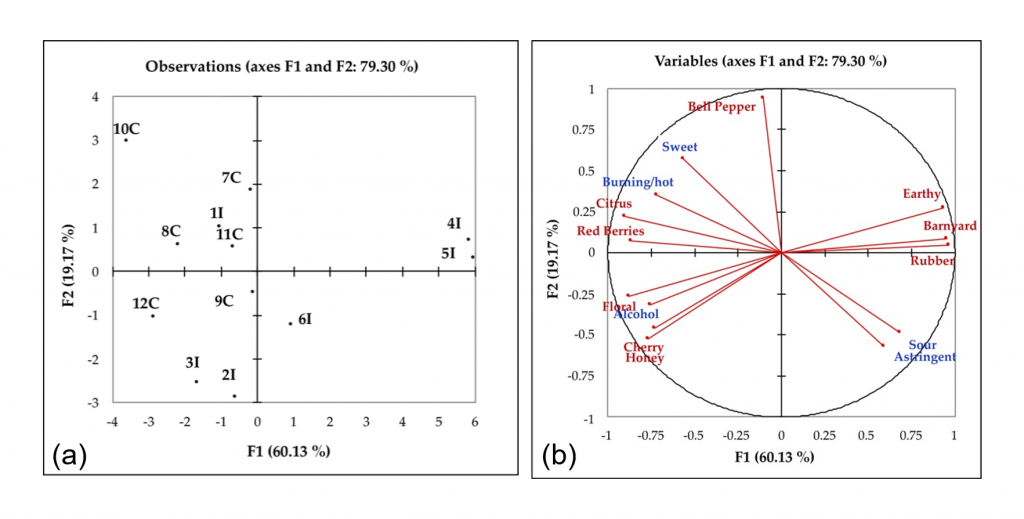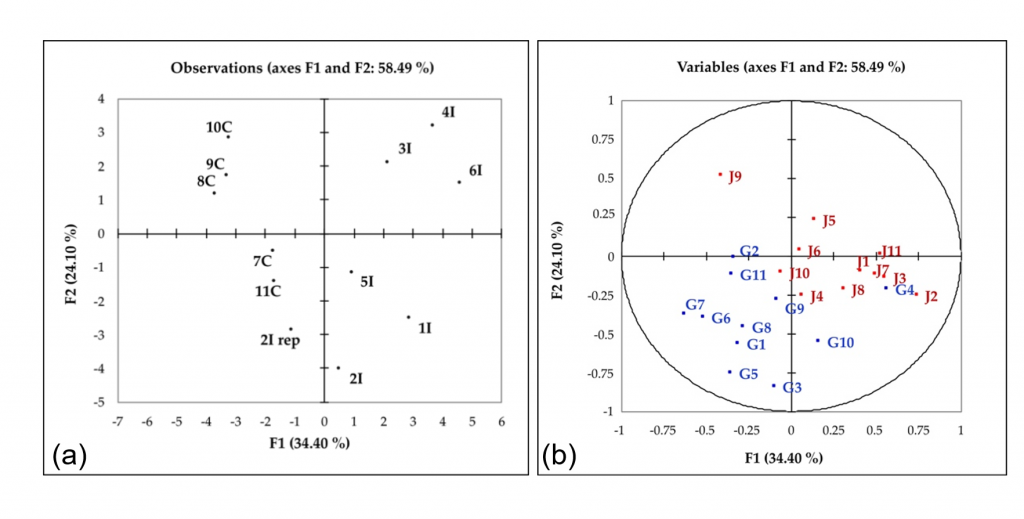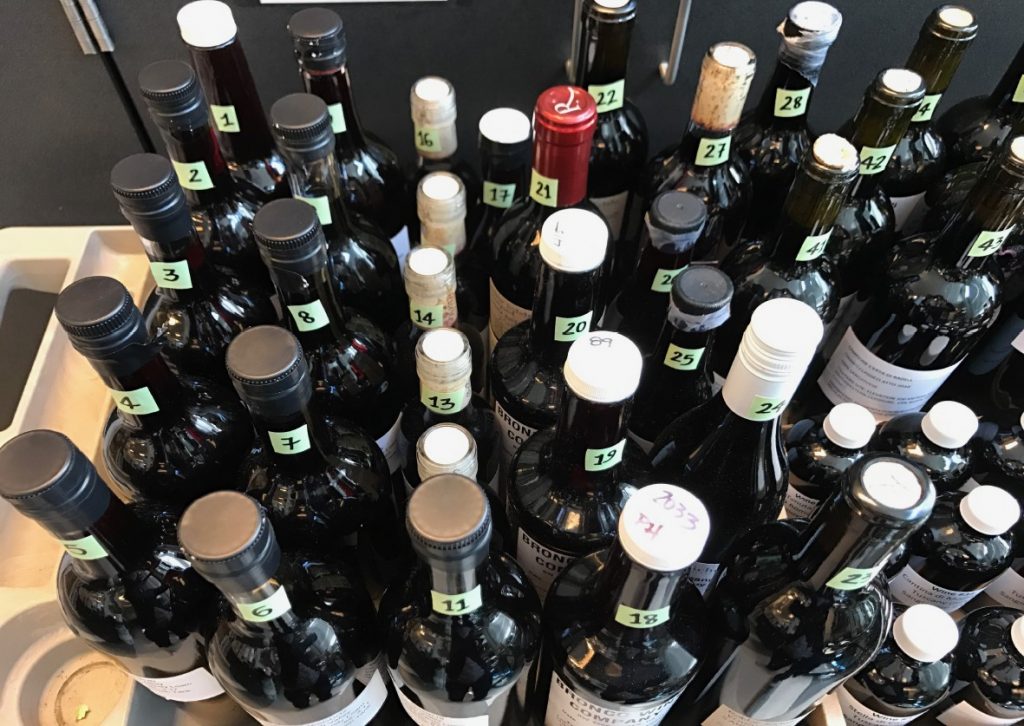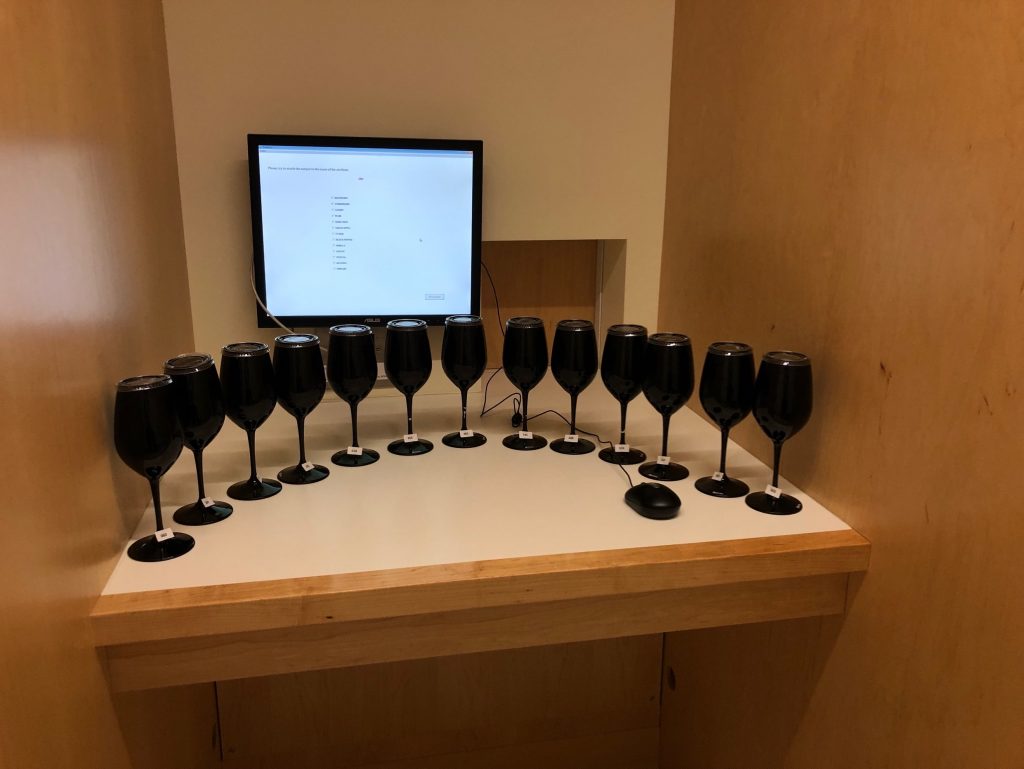by Valentina Canuti
Sangiovese is the most cultivated red grape variety in Italy where it is certified for the production of several Protected Designation of Origin (PDO) wines, and it is one of the most cultivated Italian red grape varieties in California. Despite the global distribution of this variety, there is a lack of international studies on Sangiovese grapes and wines. That was the main reason that convince the two researcher groups from the University of Florence and UCDavis to begin a two years comparison between Sangiovese wines from Italy and California.
Sangiovese wines were collected from the main wine areas in California and Tuscany, and chemically and sensory compared in order to highlight similarities and differences. The results of the first year study (2016 harvest wines) evidenced that Sangiovese from both countries had some common characteristics in particular concerning the grape-derived flavor compounds, such as vitispirane I, benzaldehyde, β-farnesene, TDN, and β-damascenone, meaning that Sangiovese variety was recognizable despite the different production country. The second year study (2017 harvest wines) the same chemical characterization was carried over together with the sensory analysis of wines in order to examine intrinsic quality of the samples, in terms of eligibility (attributes common to all wines such as pH, titratable acidity, alcohol content, volatile acidity, malic acid, and residual sugar, color intensity, hue and total phenols index) and identity profiles (attributes that distinguish among different territorial identities such as the volatile compounds originating in the grape and by the alcoholic and malolactic fermentations), and how they could reflect on the sensory perception of wines. It was interesting to see how the main differences resulted mostly for the eligibility profile. In fact, Californian wines were higher in alcohol content and pH, but showed lower amount of acidity and polyphenols content reflecting in the lighter red color of wines. On the other hand, Italian wines were more colored due to the highest content of polyphenols and in particular to the pigmented polymers and monomer anthocyanins.
Based on the chemical differences in the composition of the wines from the two regions, it was then explored how intrinsic quality, in terms of chemical differences, could be reflected on eligibility and identity sensory profiles of the wines. Moving to the perceived quality, the second target of the study was to see how Tuscan wine experts perceived the peculiarity/typicality of the Sangiovese wines from Italy and California and to link the sensory descriptors that might be associated with the wines’ typicality.
Figure 1 shows the sensory profiles of Californian and Italian wine samples and a real separation between the two regions was not completely evidenced except for the Italian wine 4I and 5I on the right side of the graph. The wines on the left resulted described by a freshness range, for which varietal aromas were perceivable in some samples, while in the ones on the right side they were hidden by some typical aromas of a full-developed wine.

When the Tuscan experts evaluated the wines, the results were different because with the Napping test Californian and Italian wines (globally evaluated except for the color) were clearly separated, evidencing that the two kind of wines were perceived differently for the gustative and olfactive characteristics. Despite of that, the results of the typicality evaluation did not show the same clear discrimination between the wines from the two regions (Figure 2) and the average score of all the wines were very similar with the Californian wines slightly higher but not significantly different.

This result can be explained by the fact that, even if the expert subjects perceived differences among the wines, they did not associate them uniquely to typicality. Given the extensive training and experience of the experts, the lack of agreement among them can be interpreted not only as a variability of their opinion but also as an indication that from the point of view of perceived quality in terms of typicality of the Sangiovese wine, the experts viewed all of the wines as falling within the identity profile. At the same time, the distribution of the higher average scores denotes that typicality has been correlated to fruity and floral attributes, in opposition to Bell pepper, Barnyard, Rubber, and Earthy descriptors (data not shown, from a PLS elaboration). In other words, the typicality of Sangiovese has been connected to the perception of the varietal characteristics that in this wine were related overall to fruity and secondly to floral.

In the case of color evaluation, the experts more clearly separated the wines (Figure 2) and overall the Italian wines had significantly higher scores. In fact, these samples, reflecting the chemical parameters, had a more intense color and overall a lower hue compared to the Californian ones.

Finally, the results from this study confirm that perceived quality in terms of typicality of Sangiovese was still related not only to fruity and floral flavors but also to lightness and freshness, despite the intrinsic quality aspect of the “structure” of the wine and to what is considered a “good” color. Moreover, the findings confirm that Sangiovese shows a flexibility in terms of chemical and sensory modification, according to the production area and that it can be considered typical even if it comes from an area far away from the traditional ones.
Sourced from the research articles:
- Canuti, V., Cantu, A., Picchi, M., Lerno, L. A., Tanabe, C. K., Zanoni, B., Heymann, H, & Ebeler, S. E. (2020). Evaluation of the Intrinsic and Perceived Quality of Sangiovese Wines from California and Italy. Foods, 9(8), 1088.
- Canuti, V., Frost, S., Lerno, L. A., Tanabe, C. K., Zweigenbaum, J., Zanoni, B., & Ebeler, S. E. (2019). Chemical characteristics of Sangiovese wines from California and Italy of 2016 vintage. Journal of agricultural and food chemistry, 67(9), 2647-2659.

Valentina Canuti, enologist, PhD. Researcher at the Department of Agricultural, Food, Environmental and Forestry Sciences and Technologies (DAGRI), University of Florence. Her research topics are focused on the influence of vinification practices on wine composition and quality. This includes studies to determine the influences of different winemaking techniques, the use of coadjutants for color and tartaric stabilization of wines. Sustainability is recently investigated as the impact of different winemaking protocol in the organic, biodynamic and conventional winery on the grape and wine quality from chemical and sensory point of view. Most of the researches are conducted on Sangiovese grape and wine.


[…] Science & Wine: Evaluation of the intrinsic and perceived quality of sangiovese wines from Calif… […]